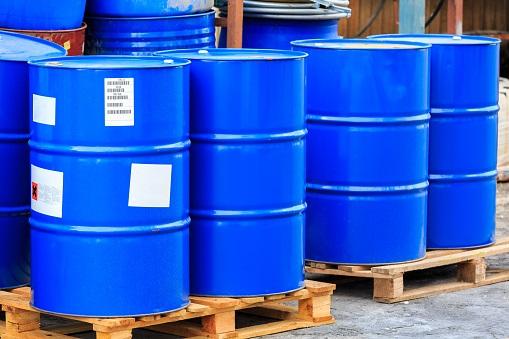Contributing Writer
- FMA
- The Fabricator
- FABTECH
- Canadian Metalworking
Categories
- Additive Manufacturing
- Aluminum Welding
- Arc Welding
- Assembly and Joining
- Automation and Robotics
- Bending and Forming
- Consumables
- Cutting and Weld Prep
- Electric Vehicles
- En Español
- Finishing
- Hydroforming
- Laser Cutting
- Laser Welding
- Machining
- Manufacturing Software
- Materials Handling
- Metals/Materials
- Oxyfuel Cutting
- Plasma Cutting
- Power Tools
- Punching and Other Holemaking
- Roll Forming
- Safety
- Sawing
- Shearing
- Shop Management
- Testing and Measuring
- Tube and Pipe Fabrication
- Tube and Pipe Production
- Waterjet Cutting
Industry Directory
Webcasts
Podcasts
FAB 40
Advertise
Subscribe
Account Login
Search
EPA wants to revise chemical storage rule
Agency wants to undo some Obama-era administrative requirements
- By Stephen Barlas
- June 7, 2018
The metal fabrication sector is among a number of manufacturing segments that could be affected by the Environmental Protection Agency’s announcement that it may toss out some aspects of the risk management rule amendments the Obama administration established in January 2017 as it was leaving town. A public hearing was held in Washington on June 14.
The general rule covers chemical accident prevention requirements for stationary sources holding a certain amount of a regulated substance. Chemicals used for cleaning equipment could be covered, for example. The EPA’s risk management program requirements include conducting a worst-case scenario analysis, providing a review of accident history, coordinating emergency response procedures with local response organizations, pulling together a hazard assessment, documenting a management system, implementing a prevention program and an emergency response program, and submitting a risk management plan that addresses all aspects of the risk management program for all covered processes and chemicals.
The Obama amendments added provisions of a wide variety, including those having to do with company audits, emergency response coordination, release of information to community groups, and incident investigations. Companies subject to the rule are divided into different program levels from one to three depending on the chemicals they store and the manufacturing processes they use. Program 3 has the most requirements and applies to processes covered by the Occupational Safety and Health Administration process safety management standard. The EPA wants to rescind some of those requirements for companies with Program 2- and 3-level responsibilities.
FAA Reform Bill Targets Airplane Manufacturing
The defect in Southwest Airline’s metal fan blade that led to a passenger’s death in April wasn’t the stimulus for the Federal Aviation Administration (FAA) Reauthorization Act of 2018, but it and a previous, similar incident from 2016 help explain why Congress is interested in upgrading manufacturing standards for airplane parts.
The woman died in the April 2018 accident because an engine fan fracture sent metal shards through her window on the Southwest Boeing 737, striking and killing her. General Electric manufactures the blades for Southwest, whose CEO Gary Kelly in May suggested the blade’s fracturing was because of coating anomalies, not metal fatigue.
The FAA bill (H.R. 4), which passed the House at the end of May with an overwhelming, bipartisan vote, has a significant “manufacturing changes” component, which earned it praise from Aric Newhouse, senior vice president of policy and government relations for the National Association of Manufacturers.
“Reforms included in the legislation would enhance the competitiveness of U.S. aerospace manufacturing through improvements to the FAA’s certification processes for aircraft design and modification and provides additional funding to assist with crucial airport and runway infrastructure improvements,” Newhouse said.
The bill authorizes creation of a Safety Oversight and Certification Advisory Committee, which would guide the FAA’s efforts to improve certification of aircraft by developing performance metrics aimed at improving the aircraft certification process. This ostensibly would increase aircraft safety in terms of how the planes are built and maintained.
Given the House vote, passage by the Senate looks to be a done deal.
New Bridge Welding Codes on the Way
The Federal Highway Administration wants to update its standards related to bridge welding. It would revise geometric design standards for resurfacing, restoration, and rehabilitation projects on highways to cite the 2017 version of bridge welding codes from the American Association of State Highway and Transportation Officials and the American Welding Society. Those codes contain chapters covering design of welded connections, workmanship, technique, procedure and performance qualification, inspection, and stud welding.
subscribe now

The Fabricator is North America's leading magazine for the metal forming and fabricating industry. The magazine delivers the news, technical articles, and case histories that enable fabricators to do their jobs more efficiently. The Fabricator has served the industry since 1970.
start your free subscriptionAbout the Author

Stephen Barlas
- Stay connected from anywhere

Easily access valuable industry resources now with full access to the digital edition of The Fabricator.

Easily access valuable industry resources now with full access to the digital edition of The Welder.

Easily access valuable industry resources now with full access to the digital edition of The Tube and Pipe Journal.
- Podcasting
- Podcast:
- The Fabricator Podcast
- Published:
- 04/16/2024
- Running Time:
- 63:29
In this episode of The Fabricator Podcast, Caleb Chamberlain, co-founder and CEO of OSH Cut, discusses his company’s...
- Trending Articles
Tips for creating sheet metal tubes with perforations

Supporting the metal fabricating industry through FMA

JM Steel triples capacity for solar energy projects at Pennsylvania facility

Fabricating favorite childhood memories

Omco Solar opens second Alabama manufacturing facility

- Industry Events
16th Annual Safety Conference
- April 30 - May 1, 2024
- Elgin,
Pipe and Tube Conference
- May 21 - 22, 2024
- Omaha, NE
World-Class Roll Forming Workshop
- June 5 - 6, 2024
- Louisville, KY
Advanced Laser Application Workshop
- June 25 - 27, 2024
- Novi, MI



























